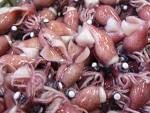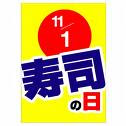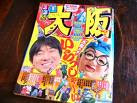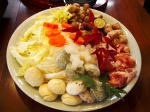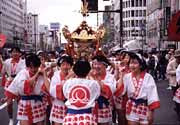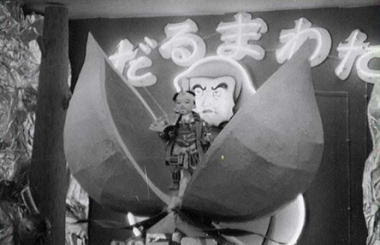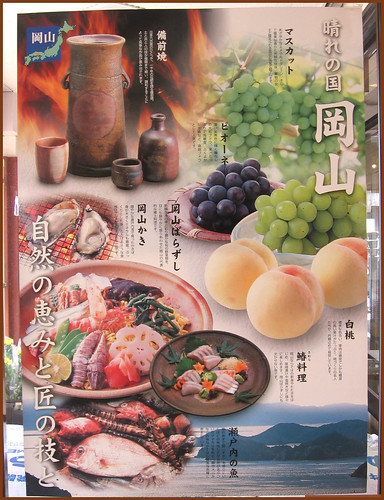! SEARCH THIS BLOG !
:::::::::::::::::::::::::::::::::::::::::::::::::::::::::::::::::::::::::::::::::::::::::::::::::::::
Tsukemono 漬物 漬け物 Japanese Pickles
:::::::::::::::::::::::::::::::::::::::::::::::::::::::::::::::::::::::::::::::::::::::::::::::::::::
How to make tsukemono
:::::::::::::::::::::::::::::::::::::::::::::::::::::::::::::::::::::::::::::::::::::::::::::::::::::
Kasuzuke (粕漬け), also Kasu-zuke is a Japanese dish made by pickling fish or vegetables in the lees (residual yeast and other precipitates) of sake, known as sake kasu.
History and variations
Kasuzuke was made in the Kansai region as early as the Nara Period, twelve hundred years ago. Vegetable kasuzuke, known as shiru-kasu-zuke or Narazuke was originally made with white melon, but later with cucumbers, eggplants, uri, and pickling melons. It was made by Buddhist monks, and used by samurai as imperishable wartime food. During the Edo period of the 17th century, a sake dealer promoted it widely. The dish spread throughout Japan and remains popular today. Carrots, watermelon rind, and ginger may also be pickled in this way.
To make shiru-kasu-zuke vegetables are pickled in a mixture of sake-kasu (in paste or sheet form), mirin, sugar, and salt. Optionally, ginger and citrus may be added. Pickling time ranges from one to three years, with the younger pickles consumed locally in the summer and the older pickles, having turned an amber color, distributed as Narazuke. To make fish kasuzuke, sugar is sometimes omitted, and Sake, soy sauce, pepper and/or ginger may be added. Typical fish include cod, salmon, butterfish and tai snapper. Brining time is one to several days.
Vegetable kasuzuke is eaten as pickles, and is sweet and mild. Fish kasuzuke may be eaten raw or grilled over rice. The flavor is mild but pungent.
© More in the WIKIPEDIA !
:::::::::::::::::::::::::::::::::::::::::::::::::::::::::::::::::::::::::::::::::::::::::::::::::::
Amazu shooga あまずしょうが(甘酢生姜)
sweet and sour pink ginger vinegar pickles
hajikami suzuke はじかみ(薑/椒) hajikami is a type of ginger
"blushing ginger pickle"
gari がり for sushi , or with fried fish
hajikami comes from leaf ginger (hashooga 葉しょうが)
端赤 。。。 はじかみ 。。。 edges are red
hajikami is a kigo for autumn
shooga no mazu-zuke 生姜の真酢漬 Eingelegter Ingwer fuer Sushi
asazuke 浅漬け lightly-pickled vegetables
. . . CLICK here for Photos !
kurz eingelegtes, schnell eingelegtes Gemüse
. WASHOKU
gooko 板井原ごうこ daikon radish pickles
Itaibara, Chizu town, Tottori
. fukujinzuku 福神漬け
Pickles for the Seven Gods of Good Luck .
:::::::::::::::::::::::::::::::::::::::::::::::::::::::::::::::::::::::::::::::::::::::::::::::::::
Kamakurazuke, Kamakura tsuke 鎌倉漬 / 鎌倉漬け
tamariboshi たまり干し pickled in tamari shoyu and dried in the sun
mostly for fish pieces, like sardines (nishin)
a kind of fish sushi
. . . CLICK here for Photos !
Kamakurazuke from the Arita area 有田 Wakayama
. WASHOKU
kiku kabura 菊かぶら / 菊蕪 "chrysanthemum turnip"
from Kamekura, Kyoto
:::::::::::::::::::::::::::::::::::::::::::::::::::::::::::::::::::::::::::::::::::::::::::::::::::
Narazuke, Nara-zuke 奈良漬
Gourd pickles
In Saketreber (Sake-Maische) Eingelegtes.
(sakekasu, Saketreber sind die Rueckstände bei der Sakeherstellung)
Eingelegtes nach Nara-Art

Narazuke seisu 奈良漬製す (ならづけせいす)
making Narazuke pickles
kigo for late summer
:::::::::::::::::::::::::::::::::::::::::::::::::::::::::::::::::::::::::::::::::::::::::::::::::::
Nozawana-zuke 野沢菜漬 nozawanazuke
pickled green leafy vegetable
Vegetable from Nozawa hot spring, Nagano.
The leaves are quite large and can be used to wrap food.
:::::::::::::::::::::::::::::::::::::::::::::::::::::::::::::::::::::::::::::::::::::::::::::::::::
Rakkyoo らっきょう(辣韮) pickled shallots
speciality of Tottori
often served with curry rice and beef dishes.
:::::::::::::::::::::::::::::::::::::::::::::::::::::::::::::::::::::::::::::::::::::::::::::::::::::
. WASHOKU
orizuke おり漬け pickles with ori dregs
dregs from the production of soy sauce

Shibazuke しば漬け / 柴漬け
Perilla pickles with eggplant
from Ohara, Kyoto. Nishiri.
This is one of the three famous pickles from Kyoto.
Made from Kamo eggplants (sometimes cucumbers, turnips, rape blossoms or other vegetables), a special kind of red chirimen aka shiso perilla ちりめん赤紫蘇 that grows in the special climate of Ohara and a lot of salt.
The ingredients are put in large wooden barrels and covered with stones of the same weight to ripen. It ferments with lactobacillus to a sour pickle, that tasts great on white rice.
Doi Shibazuke Honpo 土井志ば漬本舗 is quite famous and has tours for tourists.
This kind of pickle has been introduced by the ambulant vendor ladies from Ohara (Oharame 大原女) to Kyoto and from there to the rest of Japan. They were carrying SHIBA brushwood, firewood, on their head to sell in town and used to give a package of this pickle to their clients.
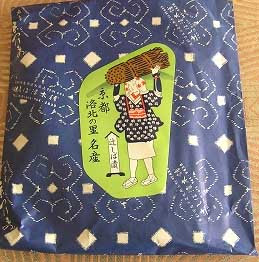 This pickle was made famous in the area of Ohara in the late Heian period, when the daughter of Regent Taira no Kiyomori fled after the lost battle of Dan no Ura. She became a nun and lived in the little monastery Jakkoin (Jakkooin 寂光院) in Ohara. Kenrei Mon-In 建礼門院 grieved about the death of her little son and the villagers brought her these local vegetable pickles to cheer her up in the hot summer.
This pickle was made famous in the area of Ohara in the late Heian period, when the daughter of Regent Taira no Kiyomori fled after the lost battle of Dan no Ura. She became a nun and lived in the little monastery Jakkoin (Jakkooin 寂光院) in Ohara. Kenrei Mon-In 建礼門院 grieved about the death of her little son and the villagers brought her these local vegetable pickles to cheer her up in the hot summer.She had it prepared by her ladies in waiting at the monastery, who were dressed like the Oharame ladies are now. So the Oharame ladies have a long history.
. . . CLICK here for Oharame dressed ladies photos !
This once-pampered great lady Kenrei is said to have composed this poem in her hermit's hut:
Did I ever dream
That I would behold the moon
Here on the mountain --
The moon that I used to view
In the sky o'er the palace?
Taira no Tokuko, Empress Dowager Kenrei (建礼門院)
:::::::::::::::::::::::::::::::::::::::::::::::::::::::::::::::::::::::::::::::::::::::::::::::::::::
sokusekizuke, sokuseki-zuke 即席漬け "impromptu pickles"
Often made from cabbage or cucumbers or shalottes.
. . . CLICK here for Photos !
Schnell gemachte Tsukemono
:::::::::::::::::::::::::::::::::::::::::::::::::::::::::::::::::::::::::::::::::::::::::::::::::::::
Takuan, takuanzuke 沢庵漬 (たくあんづけ)
Takuan radish pickles
kigo for winter
Named after priest Takuan Soho, who "invented" their making.
. . . CLICK here for Photos !
It comes in various flavors, like umeboshi or red hot peppers.
Takuwan, is a popular traditional Japanese pickle. It is made from daikon radish. In addition to being served alongside other types of tsukemono in traditional Japanese cuisine, takuan is also enjoyed at the end of meals as it is thought to aid digestion.
© More in the WIKIPEDIA !
Takuan Sōhō (沢庵 宗彭, 1573–1645) was a major figure in the Rinzai school of Zen Buddhism. He is known for his excentric life.
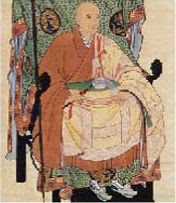 It is stated that Takuan advised and befriended many persons, from all social strata of life.
It is stated that Takuan advised and befriended many persons, from all social strata of life.Some of those include:
Miyamoto Musashi (kenjutsu swordmaster)
Matsudaira Dewa no Kami (Daimyo)
Ishida Mitsunari (Daimyo)
Kuroda Nagamasa (Christian Daimyo)
Yagyū Munenori (Daimyo and kenjutsu master, head of Yagyū Shinkage-ryū style of swordsmanship) - Takuan's writings to kenjutsu master, Lord Yagyū Munenori, are commonly studied by contemporary martial artists.
Go-Mizunoo (abdicated Japanese Emperor)
Tokugawa Iemitsu (Shogun)
Itō Ittōsai (swordsman)
© More in the WIKIPEDIA !
Zen monks are supposed to eat their slices of Takuan radish without making any noise. There are usually two slices on the plate, used to carefully clear out the bowls after eating and then munching the Takuan in silence.
If you want to know the secret of eating Takuan in silence, contact me. :o) !
dinner time -
the silence of monks
munching takuan
DAIKON . Radish and radish dishes
The Unfettered Mind. by Takuan Soho
Regional TAKUAN specialities
quote
Nanshuji Temple, Osaka 南宗寺 Nanshuuji
A temple of Rinzaishu’s Daitokuji branch built south of Shukuin in the 3rd year of Koji Period (1557) by Nagayoshi Miyoshi, who ruled Sakai as local governor of Izumi/Kawachi, in memorial of his deceased father, Motonaga. The temple burned down during the Summer Battle of Osaka, and was rebuilt in the 3rd year of Genna Period (1617) by Takuan-osho, the resident priest of the temple, in Minamihatago-cho where it remains today.
... It is said that the great masters of tea ceremony such as Sen no Rikyu and Takeno Jo-o trained here ...
source : www.osaka-info.jp
:::::::::::::::::::::::::::::::::::::::::::::::::::::::::::::::::::::::::::::::::::::::::::::::::::::

Umeboshi 梅干 the most famous
dried pickled salty plums
kigo for all summer
. WASHOKU
Umeboshi 梅干 dried pickled salty plums
Salzpflaumen
:::::::::::::::::::::::::::::::::::::::::::::::::::::::::::::::::::::::::::::::::::::::::::::::::::::
:::::::::::::::::::::::::::::::::::::::::::::::::::::::::::::::::::::::::::::::::::::::::::::::::::
Making Japanese pickles
There are many kinds of pickles and they are served when eating rice and "ochazuke", which is rice flavored with various toppings and poured with green tea. They are also served when drinking green tea and alcoholic beverages.
Shiozuke
Shiozuke is salt pickling. This the easiest way of pickling. Slice vegetables, salt them and place them under a weight for varying lengths of time. The best-known shiozuke pickled for a long time is "umeboshi". Ichiyazuke,one-night pickles, is one of "shiozuke" which is made briefly. Shiozuke is also used as preliminary step to serve food.
Nukazuke
Make "nukadoko" (pickling bed) by mixing "nuka"(rice bran) , salt and water. Then add them dried kelp and dried chilies to increase the flavor. Vegetables are buried in "nukadoko" and are kept there for varying lengths of time. You can eat it a couple of days later but the best "nukazuke" is the one which are buried for several months. Nukazuke are rich in vitamins.
The best-known examples are takuan (pickled Japanese radish) and kyuuri no nukazuke (pickled cucumber)
Read also: hinona kabu nukazuke
Here’s a little Zen of Nukazuke meditation for you…
When you mix the nukadoko and turnips take a moment to observe the wonderful colors that present and shift and fold; feel the mixture as the earth which has nurtured both the turnips and the rice grains; in the warmth you can feel the sunshine that ripened the green leaves and brought the rice grain to fruition; in the moisture you can feel the rain that fell upon the rice and turnip and gave them life; as you breath in and breath out in rhythm with your hands, you can feel your body relax….
Cate Kodo Juno
source : kyotofoodie.com . Pickling Hinona Turnips 日野菜蕪 ぬか漬け
Shooyuzuke Soy Sauce pickles
Pickle vegetables with salt, soy sauce, sugar and vinegar. It is possible to preserve vegetables for a long time. "Yamagoboo no shouyuzuke" (pickled burdock) and "fukujinzuke" (pickled 7
kinds of vegetables such as Japanese radish, eggplant etc., chutneylike pickles) are examples of "shouyuzuke".
Misozuke
Add sake to "miso" (fermented soybean paste) and pickle vegetables with them. Misozuke is originated with the fact that farmers buried salted vegetables when when they make "miso"
for their families.
Kasuzuke
"Sakekasu" is remains of the rice when making "sake" or "mirin", sweet rice wine for seasoning. A pickling bed is made by mixing "sakekasu", sugar and salt. Pickle vegetables, fish and meat. It has sweet taste and the best-know example is "narazuke"
Koojizuke
Pickle vegetables with malted rice. It can't be preserved for a long time. One of the famous "koojizuke" is "bettarazuke".
Bettarazuke (べったら漬) "sticky pickles"
from Tokyo
Karashizuke
A pickling bed is made of "sakekasu" and mustard. Pickle salted vegetables in the bed. A famous "karashizuke" is "karashi-nasu" using eggplants.
karashi renkon 辛子れんこん lotus roots with mustard
From Kumamoto
daikon karashizuke 大根からし with radish
kyuuri karashizuke きゅうりからし漬け with cucumbers
piiman karashizuke ピーマンからし漬け with bellpeppers (paprika)
shiitake karashizuke 椎茸からし漬け with shiitake mushrooms
. WASHOKU
Karashizuke からし漬け pickles with mustard
Suzuke
Vinegar pickling. Beni-shooga (pickled red gingers) and rakkyo (pickled scallions) are the best-know examples of "suzuke".
source : ytoshi.cool.ne.jp
Melon Pickles
Japanese LINK : 漬け瓜(越瓜 本瓜) 夕顔 とうがん
*****************************
Worldwide use
*****************************
Things found on the way
*****************************
HAIKU
Kobayashi Issa
梅干と皺くらべせんはつ時雨
umeboshi to shiwa kurabesen hatsu shigure
comparing my wrinkles
with the pickled plums...
first winter rain
"Pickled plum" (umeboshi) is an idiom denoting an old wrinkled woman
福豆や福梅ぼしや歯にあはぬ
fuku mame ya fuku umeboshi ya ha ni awanu
lucky beans
lucky pickled plums...
yet no teeth
Issa has no teeth left with which to chew these end-of-year treats.
Tr. David Lanoue
ich vergleiche meine Falten
mit einer Salzpflaume ...
erster kalter Regen
Tr. Gabi Greve
:::::::::::::::::::::::::::::::::::::::::::::::::::::::::::::::::::::::::::::::::::::::::::::::::::::

物言はぬ独りが易し胡瓜もみ
mono iwanu hitori ga yasushi kyuuri momi
so good to be alone
with no need to talk . . .
kneading salted cucumbers
Tr. Gabi Greve
Abe Midorijo 阿部みどり女 (1886 - 1980)
この宮の我も氏子よ札納
. kono miya no ware mo ujiko yo fuda osame .
keichitsu ya yoji no gotoku ashi narashi
yume no ato oute hare nari sawayaka ni
MORE about Midorijo : thegreenleaf.co.uk/hp/women
*****************************
Related words
***** Gourd Pickles
***** WASHOKU : Tsukemono Pickles
:::::::::::::::::::::::::::::::::::::::::::::::::::::::::::::::::::::::::::::::::::::::::::::::::::::
[ . BACK to DARUMA MUSEUM TOP . ]
[ . BACK to WORLDKIGO . TOP . ]
:::::::::::::::::::::::::::::::::::::::::::::::::::::::::::::::::::::::::::::::::::::::::::::::::::::





